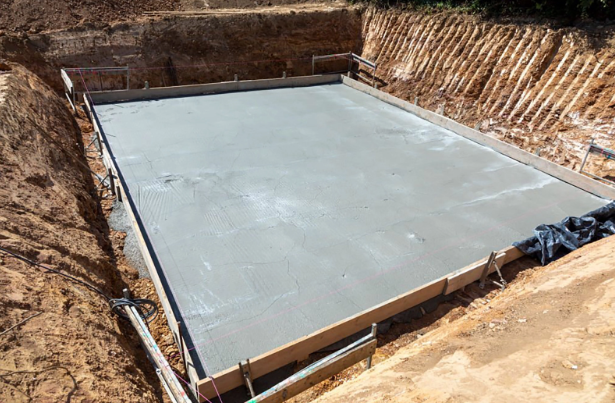Most buildings, regardless of their purpose, are erected on a prepared foundation. Such structures are called foundations. Depending on the soil characteristics and the expected load, a slab, strip, columnar or pile-screw type support is installed.
Slab foundation
A foundation of this type is represented by a monolithic reinforced concrete slab, the dimensions of which slightly exceed the perimeter of the building. Otherwise, such a foundation is called a floating one. Structurally, it can be represented by a prefabricated platform made of ready-made sheets or a poured seamless plane. For pouring the foundation, it is recommended to use concrete of at least grade M250 . The most popular grade for the foundation is considered to be grade M300 . When choosing a grade/class of concrete for arranging the foundation, it is necessary to remember that all further load will fall on the foundation and the strength and durability of the structure will depend on the quality of the selected concrete.
The advantages of a slab foundation are considered to be the following:
- The load from the building is distributed evenly across the entire site, which eliminates localization of pressure on the ground. This reduces the risk of the house subsiding or skewing.
- The applicability of the slabs includes marshy and heaving soils . Seasonal movements and groundwater have virtually no effect on the general condition of the supporting foundation of the house.
- The admissibility of constructing a basement floor at different depths.
Pro Tip: Looking for reliable concrete repair services in Guelph? We specialize in fixing cracks, restoring surfaces, and ensuring durable concrete solutions. Call us today!
However, there are a number of disadvantages that complicate the choice of a solid foundation:
- The final construction estimate significantly exceeds the amounts for the construction of other structures. This is explained by the large amount of concrete mortar, sand, crushed stone for organizing a cushion under the slab, iron for the reinforcing frame. The issue of renting special equipment is also taken into account: a concrete mixer (stationary or machine), a vibrator or a truck crane.
- The foundation poured on site becomes suitable for use only after 28 days according to the technology. During this time, the concrete gains strength and dries. It is important to observe and create specific conditions for the correct process of forming the slab. These include maintaining the temperature and humidity conditions.
- A foundation of this type excludes changes in relation to integrity. All utility lines are laid before pouring the cement mortar. It is impossible to arrange a basement after the foundation has been erected. It is only permissible to arrange a basement floor at the initial stage of building a house.
The technology of installing a slab foundation of a building is represented by three steps. First, a layer of soil of the required height is removed. Then, a cushion of crushed stone and sand is rammed and leveled. After that, ready-made canvases are laid or a reinforcing frame with a formwork fence is poured.
Strip foundation
Such a foundation also belongs to the group of monolithic foundations. However, it is erected to support only the load-bearing walls, partitions of the future building. Also, in relation to the solid execution, there is a mandatory deepening. Structurally, there are several subtypes of the strip support structure:
- Solid cast is represented by a seamless base. It is used for the construction of low-rise buildings, fences. Characteristic features are stability on any soil, the possibility of construction without a truck crane.
- The prefabricated one consists of individual factory-made blocks. The constructor is assembled using cement mortar as a binder between individual elements. This type of foundation is used for garages, utility buildings, lightweight houses up to two floors with an attic. Pros: simplicity, speed of installation. Cons: lifting equipment is needed, construction is only allowed on stable ground.
- A shallow strip foundation is built not below the level of soil freezing (up to 50-70 cm). Therefore, it is suitable for a one-story house made of logs or frame structures. Garages, sheds, gazebos, workshops, fences are also acceptable. Stability is required in relation to climate and soil. The positive aspects are a small estimate, simplicity in relation to foundation preparation.
- Deep strip foundation (up to 1.5 m) is applicable for the construction of multi-storey buildings. It is permissible to install underground spaces for various purposes. There are fewer requirements for soil and climate than for shallow foundations.
The installation technology is similar to the rules for installing a slab foundation. Only additional trenches are dug, and more protective materials will be needed to protect the outer surfaces from moisture, acids, and alkalis. It is also necessary to more carefully calculate the load in order to correctly determine the depth of occurrence and the grade of concrete.
Columnar foundation
Such a support structure is fully or partially made of reinforced concrete, brick, stone, wood or metal. The support points are located at the corners of the future building, at nodal points. Additionally, pillars can be installed in places that compensate for high loads. By analogy with the strip, the construction of supports occurs only under the load-bearing structures of walls and partitions.
Compared to monolithic foundations, columnar foundations are approximately 2 times cheaper. You can build them yourself, since it is enough to dig a small hole, compact the drainage embankment, and build a column. Such a support foundation is used on any soil. It is noteworthy that it is permissible to build houses on an inclined surface. But there are restrictions regarding heavy buildings; it is impossible to make an underground room. And a reliable grillage is also required to prevent horizontal displacement of the building.
Pro Tip: Need professional foundation repair in Guelph? We offer expert solutions for cracks, settling, and structural issues. Contact us for reliable services!
Pile-screw
This is the cheapest type of supporting foundation for a building (by 30-50%), which has large restrictions regarding the load. Only piles are needed for its construction. They are made of a hollow metal profile of a round cross-section. Blades are fixed to one end, which form a spiral. As a result, the piles are simply screwed into the ground.
In addition to the cost, the advantage of a pile foundation is its applicability to any terrain. You can even build a house on water. The installation technology is extremely simple. Special equipment is acceptable, but not required, if the work is carried out on land. There is also no dependence on the relief, seasonal behavior of soils, depth of groundwater and freezing, climate, weather conditions during construction. Walls can be erected immediately after screwing in the piles.
Disadvantages include the difficulty of installation on rocky soils and among rocks. Incorrect load calculation leads to deformation of the strapping belt, destruction of the house. Metal corrodes, so piles should be selected only from a trusted supplier. It is not recommended to use such a foundation near railway tracks for electric trains, cell towers, deep mining, quarries, and high-voltage lines. A separate grounded circuit must be installed. And the cavity of the piles must be completely filled with cement mortar.
Conclusion
When choosing the type of foundation, it is necessary to take into account the soil characteristics, the depth of freezing, and the relief of the soil. It is also important to correctly calculate the load of the future structure. The effectiveness of the result depends on compliance with the installation technology and the quality of the materials used.



